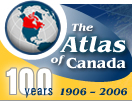|
The role of the Canadian Heritage Rivers System
is to develop appropriate management programs that will enhance the diversity
of Canada’s outstanding rivers. Projects are evaluated on
the basis of natural, cultural and recreational values. Three of Canada’s
28 Heritage Rivers flow in Nunavut: the Thelon, Kazan and Soper rivers.
A fourth, the Coppermine River, is proposed as a watercourse having heritage
potential. As these rivers reflect the physical and cultural heritage
of Nunavut, considerable detail is given below for all four of them.
Thelon River
The Thelon sweeps majestically out of spruce-lined valleys, winding across
the barrens through vast lakes set like mirrors in the treeless tundra,
and finally emptying into Baker Lake. For the Inuit of the village of
Baker Lake, the Thelon remains a vital source of caribou, fish and also
spiritual renewal. The remains of Inuit campsites are found all along
the Thelon, testimony of a time not long ago when it was the homeland
of the nomadic Caribou Inuit. They followed vast herds of caribou - hundreds
of thousands strong – which still migrate in this area. The Thelon
River is the largest in Nunavut; it drains an area of 142 000 square kilometres.
Kazan River
From its source near the northern fringes of the boreal forest in northern
Saskatchewan, the Kazan flows onto the treeless tundra and runs
northward for 1000 kilometres to Baker Lake. The valley of the Kazan
was an important hunting ground, and vast herds of caribou, along
with muskox, wolves, and other arctic wildlife can still be found
here in abundance. At Kazan Falls, the river plunges 25 metres and
then rushes for two kilometres through a red sandstone gorge. The
Inuit left marks that are now an integral part of the landscape,
such as the human-shaped piles of rocks called “inuksuit”.
On the Kazan River, 186 archaeological sites have been discovered
over a distance of 500 kilometres. The Kazan River drains an area
totalling 71 500 square kilometres
Soper River
The Soper River winds through the tundra-covered hills of southern Baffin
Island. As its valley is sheltered from harsh winds it has created a microclimate
that is slightly warmer than ecosystems found at similar latitudes. Consequently,
the river supports a forest of willows up to 3.6 metres high, and a lush
profusion of Arctic wildflowers. The Inuit have used this river as a vital
source of food and travel for thousands of years. Soper Falls, near its
mouth, displays a special hydrographic feature in the phenomenon of a
reversing current caused by the high tides of Hudson Strait. The river
gets its English name from a biologist, Dewey Soper, but is also known
as Kuujuak, or Great River, in Inuktitut.
Coppermine River (proposed)
The Coppermine River has been proposed as a heritage river because of
its rich cultural history, natural significance and recreational opportunities.
The Coppermine runs northwest, 845 kilometres from Lac de Gras near Great
Slave Lake. The community of Kugkluktuk is located at its mouth where
it enters Coronation Gulf. As the name ‘Coppermine’ suggests,
the mineral copper can be found lying on top of the ground in nugget form
along the lower stretches of the river. Copper was, and still is, used
by the local Inuit (also known as Copper Inuit), to fashion tools. The
human habitation of the Coppermine valley goes back at least 3000 years.
Samuel Hearne was the first European explorer to travel down the river
in 1771. While exploring in this area, in 1772, he witnessed the massacre
of a local Inuit group by a Chipewyan tribe he was travelling with at
Bloody Falls.
The Coppermine River has carved a valley that provides a sheltered corridor
for the flora and fauna of the region, and for the human traffic
moving north into the Arctic. The river is increasingly being explored
by canoeists and whitewater adventurers. Bloody Falls Park, located
13 kilometres south of Kugluktuk, is a popular camping and fishing
spot for travellers and local people. The river, itself, is home
to many species of fish including Arctic Char, Lake Trout and Arctic
Grayling. The valley provides habitat for a variety of animals and
birds such as moose, grizzly bears, golden eagles and peregrine
falcons.
|
